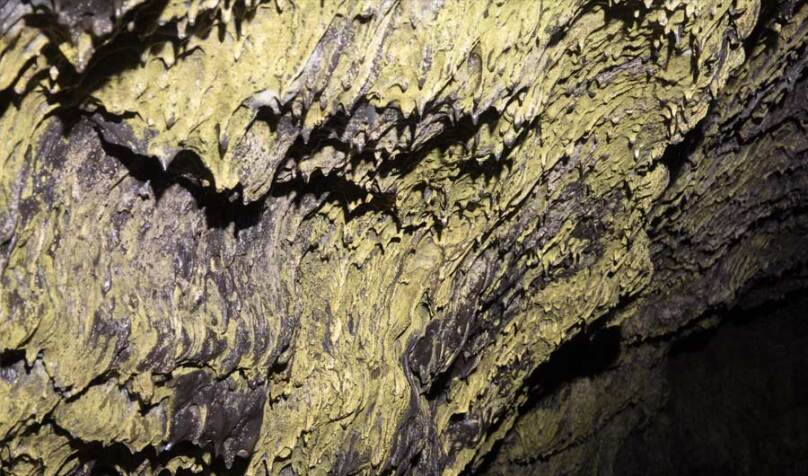Life in Lava Caves Ignores Food from the Surface, Eats Rock Instead

In lava caves in California, microbes coat the walls in complex living layers called biofilms.
Brian Anschel
(Inside Science) -- Some living things in Earth’s lava caves have no need for resources from the surface, suggesting similar environments could host life on Mars, according to new research.
Lava caves, also known as lava tubes, are formed during volcanic eruptions when an outer crust of flowing lava hardens. The molten middle continues to drain away, leaving tunnels that can be several yards across. These tunnels may become buried under soil, but they often remain shallow enough that water can seep in, laden with food from the surface.
But researchers found that many bacteria growing on the walls of lava caves spurn the feast flowing over them. Instead, they produce their own energy from surrounding minerals or dissolved chemicals and build the molecules they need using carbon in the air or rock.
“This means that even in a very well-connected environment in the shallow subsurface, we still have evidence for life that is very independent from the surface living and thriving,” said Matthew Selensky, a geobiologist and doctoral candidate at Northwestern University in Evanston, Illinois. Selensky conducted the study with his advisor Magdalena Osburn and their colleagues. The study is part of NASA’s BRAILLE Project, which works to study life in volcanic caves as an analog for possible life on Mars.
Life without sunlight
All living things need a source of energy to power their activities and a source of carbon to use as building material. Plants and other photosynthetic organisms get their energy from the sun, and they transform or “fix” the carbon in carbon dioxide into forms that are useful for living organisms, typically using a process called the Calvin cycle. Other creatures like humans and fungi get their energy and carbon by eating the remains of living things, essentially mooching off the work of photosynthesizers.
At least, that’s how it usually works on Earth’s sun-drenched surface. But there are other energy sources around, such as the chemical bonds of minerals and other inorganic material. Researchers have long known that some microbes use these chemical resources to produce energy in ways that don’t rely on the sun. Most such organisms also fix their own carbon from minerals or CO2, often using other methods besides the Calvin cycle.
“Organisms that use other sources of energy besides solar energy exist pretty much everywhere on the planet,” said Caitlin Casar, who earned her doctorate in the same lab as Selensky but was not involved in the new study. “You can find them at the surface of the Earth, you can find them in soil, you can find them deep in the Earth’s crust, you can find them at the bottom of the ocean, in the ocean’s water column, in the air.”
Most research on organisms that produce their own energy without sunlight has focused on deep, isolated places that receive very little food from the surface, according to Osburn. Lava caves are a sort of middle ground, shut off from light but still connected to the sunny world above. To find out how life makes a living in such environments, Selensky and his colleagues squeezed through narrow cave mouths in California’s Lava Beds National Monument.
The lava cave walls sported everything from goopy ooze to coral-like nodules, but the most obvious signs of life were thin yellow, tan or white layers called biofilms, said Selensky. Composed mostly of bacteria, these biofilms have hydrophobic surfaces that collect sparkling drops of water, leading to their nickname “cave gold.”
“It looks like someone’s thrown a bucket of gold paint and then sprinkled tiny diamonds,” said Jennifer Blank, one of the study authors and lead investigator of NASA’s BRAILLE Project.
The researchers collected samples from all over the cave, then analyzed a subset of the carbon-based molecules they contained -- specifically, fats found in cell membranes. Carbon atoms come in two stable forms: the more abundant isotope C-12, and a scarcer isotope called C-13. The amounts of C-12 versus C-13 in the bodies of living things depends on whether the carbon was fixed by the Calvin cycle, as is typical in plants and algae, or by one of the other methods often used by microbes that don’t rely on sunlight.
As expected, the researchers found that the water seeping in from the surface was full of carbon that had been fixed by plants or other photosynthetic organisms using the Calvin cycle. Some cave features appeared to contain microbes that lived off this surface food, “sort of fighting for table scraps,” said Selensky. But in biofilms, some types of molecules the researchers examined had C-13 levels that were much lower. This indicates that a large fraction of the bacteria in the biofilms were surviving off the minerals and CO2 in the cave -- a lifestyle known as chemolithoautotrophy, or lithoautotrophy for short, according to Selensky.
“The assumption for a lot of people is that if you’re on the surface or close to the surface, you have this amazing energy source, the sun … and essentially photosynthesizers can outcompete everything else,” he said. “I do think that lithoautotrophy is almost an underestimated metabolism in these environments.” The findings
A guide toward life on Mars?
While researchers still don’t know for sure what Mars contains in the way of caves, the red planet is thought to have many lava caves similar to (though likely larger than) those on Earth. There probably aren’t any trickles of food-laden surface water in Martian lava caves because the surface of Mars is dry and too harsh to support life. But the caves might contain water in the form of ice, as well as a variety of minerals that could serve as fuel for life. Such caves would also be protected from the toxic radiation and extreme temperature fluctuations of the surface, making them potential oases for living things now or in the past.
“The presence of active lithoautotrophy in these lava tube caves in California really shows that these types of environments can sustain a community based on lithoautotrophy, so we don’t necessarily need abundant organic matter coming down from the surface,” said Richard Leveille, an astrobiologist at McGill University in Montreal, Canada. “It bolsters the idea that you could have microbes living in lava tube caves on Mars.”
Leveille was not involved in the new research, but he collaborates loosely with Selensky’s team, and he recently conducted a related study with his doctoral student Brady O’Connor. Some of the caves in Lava Beds National Monument contain ice year-round, and Leveille and O’Connor found microbes in that ice
However, Leveille and O’Connor couldn’t tell whether the DNA they found came from microbes actively feeding on minerals in the ice, or whether the ice had simply preserved remnants of long-dead lithoautotrophs. In contrast, Selensky and Osburn’s team clearly showed that the cave biofilms were full of live bacteria actively feeding on minerals, said Leveille. That’s because their study focused on molecules from cell membranes that break down rapidly after a cell dies.
Still, Martian lava caves may not be hospitable to living things today, Leveille cautioned. Even in ice, organisms need fissures or pockets of liquid water to live in an active state, and it’s possible that Martian lava caves are just too cold and dry.
Indeed, Blank doesn’t expect that a mission to Martian lava caves would discover living organisms. But the same features that could have protected cave life in Mars’s distant past might have preserved evidence of that life until the present day. Microbes often change how minerals precipitate out of water, and researchers could detect those changes in the layers of silica and other minerals on the cave walls.
“This to me would be exciting, and would really make me think that there had been life there,” said Blank.
Lindsay Hays, deputy program scientist at NASA’s Mars Sample Return and Astrobiology programs, said the findings were interesting and worth investigating further, although they’re not enough on their own to make NASA change its priorities and rush to explore a lava cave. That’s partly because caves present logistical challenges, and engineers would have to design new types of robots capable of clambering around in such environments and transmitting data up through the rock.
Studies like Selensky’s offer another sort of boon to Mars exploration, though: They show what kinds of instruments we might need to make sense of what we find.
“One of our continual improvements at NASA is thinking about not only how do we go to new places and explore new things, but how do we improve the tiny hardened instruments that we bring with us?” said Hays. Currently, scientists couldn’t do the kind of isotope analysis Selensky performed with anything they could send to Mars. But, said Hays, NASA-funded researchers could potentially work to develop such an instrument -- “so that in the future, we could put this on a rover and send it into a cave.”


